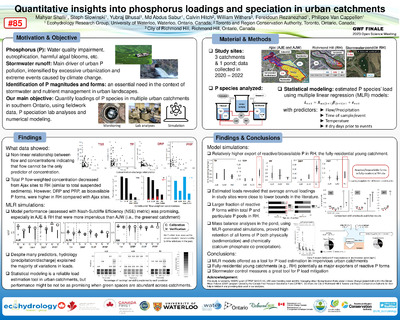| dc.contributor.author | Shafii, Mahyar | |
| dc.contributor.author | Slowinski, Stephanie | |
| dc.contributor.author | Bhusal, Yubraj | |
| dc.contributor.author | Sabur, Md Abdus | |
| dc.contributor.author | Hitch, Calvin | |
| dc.contributor.author | Withers, William | |
| dc.contributor.author | Rezanezhad, Fereidoun | |
| dc.contributor.author | Van Cappellen, Philippe | |
| dc.date.accessioned | 2023-06-19 18:31:22 (GMT) | |
| dc.date.available | 2023-06-19 18:31:22 (GMT) | |
| dc.date.issued | 2023-05-16 | |
| dc.identifier.uri | http://hdl.handle.net/10012/19569 | |
| dc.description.abstract | Phosphorus (P) loadings in stormwater runoff drained from urban landscapes causes eutrophication in aquatic ecosystems downstream of urban areas. Many recent research have addressed urban P dynamics to improve understanding about magnitudes and speciation of P in urban watersheds. We quantified P export and forms in four research sites including three urban sewersheds and a stormwater pond, all located within the drainage basin of Lake Ontario. P speciation laboratory analyses were conducted on water and sediment samples taken from our sites to measure a suite of P species, including total P (TP), total dissolved P (TDP), dissolved reactive P (DRP), dissolved unreactive P (DUP), particulate P (PP), and particulate reactive P (PRP). Using multiple linear regression (MLR) models, we quantified annual loadings of these P species, which appeared to be close to the lower limit of ranges reported in the literature. Average loadings among urban catchments were 0.54 kg ha-1 yr-1 for TP, 0.064 kg ha-1 yr-1 for TDP, 0.007 and 0.045 kg ha-1 yr-1 for DRP and DUP, 0.46 kg ha-1 yr-1 for PP, and 0.16 kg ha-1 yr-1 for PRP. Results indicated that larger catchment-scale loadings of reactive P species (DRP and PRP) were exported as residential development increased. We also found that the pond retained all P species significantly (77-94%), which, according to mass balance and sequential P extraction analyses, was attributed to both sedimentation and chemical precipitation of P with calcium mineral phases. Findings in our study imply that, due to loadings’ variability imposed by land-use characteristics, urban P management options need to vary from a catchment to another. Furthermore, enhancing the formation of calcium phosphate and other redox-stable mineral phases could be explored as a best management practice in existing and new ponds for improving P retention. | en |
| dc.description.sponsorship | This research was undertaken thanks, in part, with support from the Global Water Futures Program funded by the Canada First Research Excellence Fund (CFREF). | en |
| dc.language.iso | en | en |
| dc.publisher | University of Waterloo | en |
| dc.relation.ispartofseries | Global Water Futures; | |
| dc.rights | Attribution-NonCommercial-NoDerivatives 4.0 International | * |
| dc.rights.uri | http://creativecommons.org/licenses/by-nc-nd/4.0/ | * |
| dc.subject | GWF ASOM 2023 | en |
| dc.title | Quantitative insights into phosphorus loadings and speciation in urban catchments | en |
| dc.type | Conference Poster | en |
| dcterms.bibliographicCitation | Shafii, M.; Slowinski, S.; Bhusal, Y.; Sabur, M.A.; Hitch, C.; Withers, W.; Rezanezhad, F. & Van Cappellen, P. (2023). Quantitative insights into phosphorus loadings and speciation in urban catchments. Global Water Futures (GWF) Annual Open Science Meeting Conference. University of Waterloo. | en |
| uws.contributor.affiliation1 | Faculty of Science | en |
| uws.contributor.affiliation2 | Earth and Environmental Sciences | en |
| uws.typeOfResource | Text | en |
| uws.peerReviewStatus | Unreviewed | en |
| uws.scholarLevel | Staff | en |


